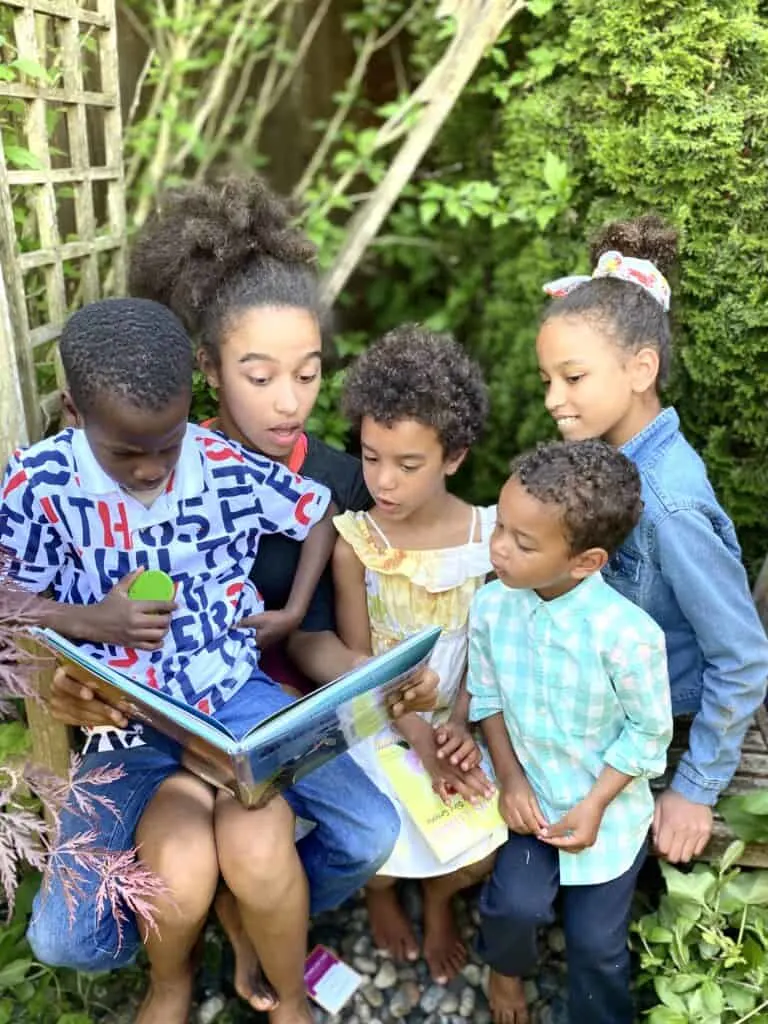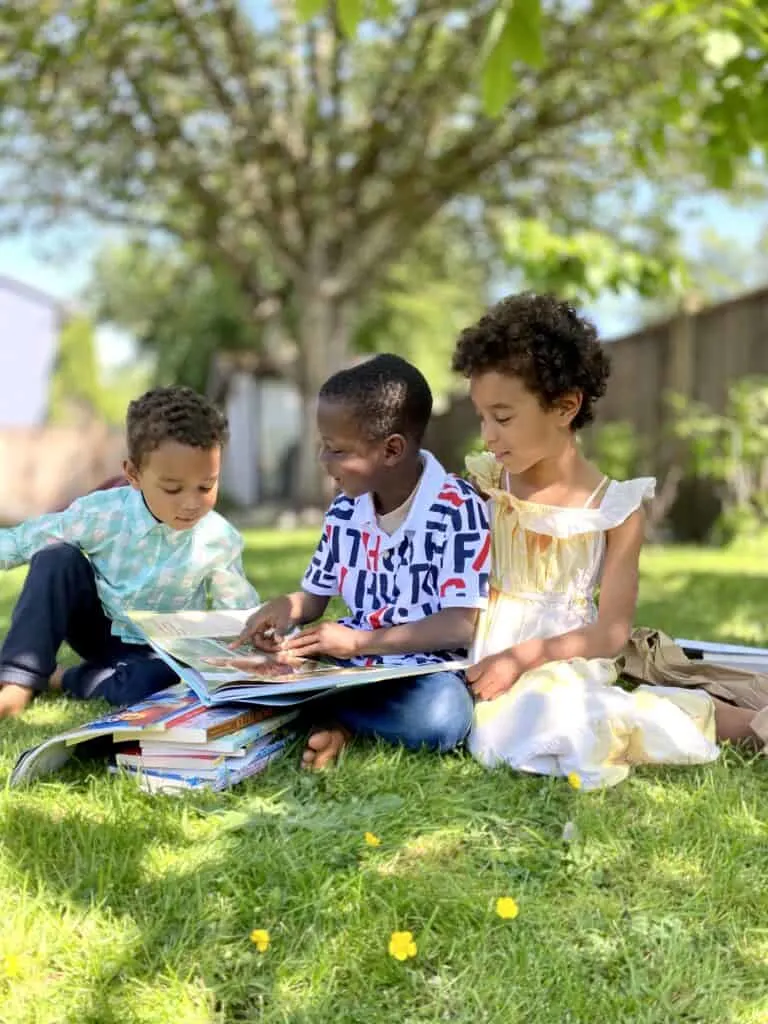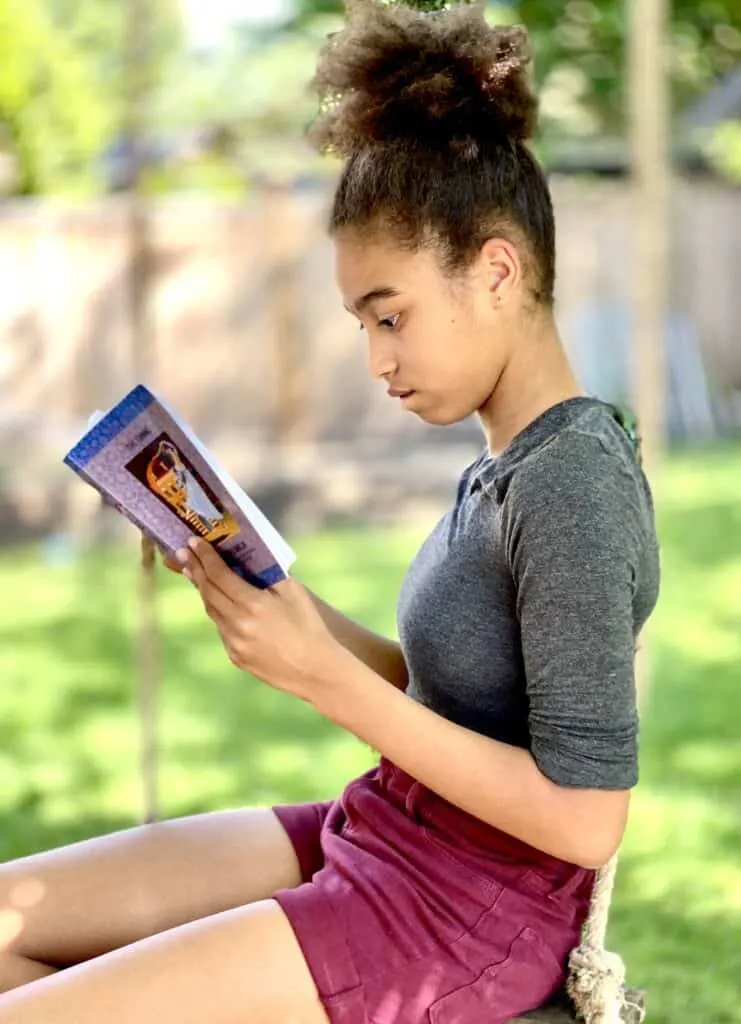Balancing your role as parent and teacher in a homeschool setting is tricky. Homeschooling parents wear a lot of hats—Mom or Dad, chauffeur, chef, coach, counsellor, administrator, housekeeper, and, of course, teacher. As we stretch ourselves thin trying to be everything to everybody, our kids can get confused and may struggle to differentiate between Mom the Parent and Mom the Teacher. Here are four reasons why this happens and what you can do about it.

Disclaimer: I am a Sonlight Ambassador, which means I receive complimentary Sonlight curriculum in exchange for sharing about our experiences as a Sonlight family. All opinions are my own. Learn more.
It has to be one of the most frustrating things about parenting: our kids listen to literally anybody else better than they listen to us.
My three-and-a-half year old son goes to daycare twice a week. It takes me an hour to get him ready to go there because of his stonewalling, dilly dallying, and general efforts to undo any progress I make toward getting him dressed.
Bribery, threats, bargaining: none of these have any effect on his behaviour.
The difference is remarkable, however, when I pick him up. His teacher spots me from the window, and says, “Mom’s here, buddy.”
That’s it. Within a minute, he has removed and stored his indoor shoes, put his boots on the right feet, donned his sweater and coat, gathered his belongings and said goodbye to his friends. By the time I’m at the door, he’s ready to go.
When I mention to his teacher how hard it is to get him to do anything at home, she almost doesn’t believe me. “He listens perfectly here,” she tells me. I don’t know whether to cry or to celebrate when I hear that.
But, truth be told, this is the norm, at least for my kids. They’ve always responded better to instructions from other people than they have from me. Which, to my great consternation, does cause friction in our homeschool.
Why is it that they feel the need to disagree with me when I say, “It’s time for science,” when I know they would never respond to a traditional teacher in that way? And how are we supposed to get anything accomplished in that environment?
Here are four reasons why kids react this way to the efforts of their parent-teachers and what we can do to bridge the parent teacher gap.
1. The social dynamic is different

In a school setting, kids are surrounded by their peers, all of whom are subject to the same teachers, courses, workload, etc. If the bell rang at school and all of your child’s friends went off to class while your child stayed behind in the cafeteria finishing lunch, it probably wouldn’t go over too well.
There is a clear expectation at school that everyone will follow the schedule and the instructions set forth by the teachers and administrators, and kids have been conditioned since kindergarten to follow those expectations. It becomes second nature.
At home, the expectations may not be as clear, and there may not be social pressure to conform. If your siblings are sitting around in their pajamas eating another bowl of Gorilla Crunch, you’re going to find it unfair if Mom tells you it’s time to take out your math book. And there really isn’t anyone there to say, “Hey, come on. We better get to math before we end up in detention.”
You can recreate this dynamic at home, it just takes a bit more work. When kids know what is expected of them, they’re much more likely to comply with those expectations. If they feel like they’re chasing a moving target, they’re going to get frustrated and give up.
I’ve also found it helpful to bring in some of the social aspect that school-going children find naturally. When my kids try to make plans with their homeschooled friends, and their friends explain what their own “school day” and workload look like, my kids get a better understanding of the school time/non-school time balance. They see that it’s normal for a homeschooled child to spend four or five hours a day doing their learning (at an upper elementary/middle school level), and they accept it for what it is.
Also, they know that the neighbourhood kids will return from school in the mid-afternoon and this provides another incentive to get their work done. If they want their “school day” to be done in time for them to play with their friends, they know they need to put in the work earlier in the day. A simple reminder that three o’clock is approaching is often all they need to buckle down.
2. They feel more comfortable with you

I always find this statement bittersweet. Your kids act better with everyone else because they’re more comfortable with you. They can be their true selves around you, but they have to put on their best behaviour around others.
I hear this all the time when people tell me how well-behaved my kids are when I’m not around. I’m like, what kids? My kids? Are you sure?
Why, why, why do they have to save that for other people? I’m the one putting in all the work here to teach them those behaviours; shouldn’t I get to see some of the fruits?
Now that I have a wide age spread between my youngest and oldest (three to thirteen), I am starting to see some of those fruits, and I see how those good behaviours do start to become more of the norm as kids mature. But I still see the truth in those statements, especially in my younger kids. They would never, ever act with other people the way they do with me.
We can choose to be eternally frustrated about this, or we can take it as a compliment and use it to our advantage. Our kids feel most comfortable with us. What does that mean for homeschooling?
It means they’ll allow us to see weaknesses they may try to hide from other people. It means we have an opportunity to know them more deeply and to tailor their education to their personalities and needs. It means we can come alongside them as a coach and trusted leader, not just as a teacher.
We can learn to lean in to the resistance our kids display and find out what’s at its roots. We can to learn to work with them, rather than fighting against them. We can adopt tones and attitudes that encourage them through their resistance instead of causing them to lock into their stance.
Yes, sometimes kids just don’t put on their shoes because they don’t want to put on their shoes and they won’t do their math because they just don’t want to do their math. And I’m not saying we can let that slide consistently. But if there is a pattern of resistant behaviour, you can sink into your parental relationship with your child, discover what’s going on, and work together to overcome it.
3. The environment is different

In the spring of 2020, millions of people learned just how challenging it can be to work from home. My husband used to think people stopping by his desk at the office was a distraction. Now that he works from home full-time, I’m guessing his stance on that has changed. Even though we try to leave him alone as much as possible, he’s interrupted frequently to move heavy things, examine wounds, take a coffee break with his wife, answer the door, ooh and ahh over art projects, and counsel children through epic fights.
But he’s an adult who is getting paid to do a job, and he’s developed coping mechanisms to help him tune out the majority of the distractions.
It’s much harder for children.
Imagine trying to grasp a difficult new subject while your younger sister sits across the table practicing Spanish on Duolingo, your two youngest siblings are fighting over a toy, your mom is talking on the phone, and lunch is boiling over on the stove. It’s pretty much impossible.
Homeschool is not meant to be school at home, but we can borrow some of the frameworks of the school system if we’re struggling to get our kids to respect us as their teachers.
Although every family is different, and each child will respond differently to different environments, I’ve found that structures, routines, and schedules are absolutely vital in my homeschool if I’m going to receive cooperation from my children.
As we’ve already discussed, when kids follow a schedule and a routine, the process becomes second nature. If they know that they are going to do social studies every day after quiet time, it won’t take long before you no longer need to announce that fact every day. Even the youngest of students will intuitively understand the routine and will actually become disappointed when it’s interrupted.
I use Google calendar to map out our homeschool days. Each kid is a different colour and I create thirty to sixty minutes for each subject, depending on their ages, how frequently they do the subject, and how involved each lesson is. We leave space in between subjects for breaks and we leave lots of room in our schedule for free time and for margins before and after activities.
My kids can access this schedule on the computer, but I also print it out each week and put it on the fridge and it’s also written on whiteboard paper posted throughout the house. Nobody has any excuse to not know what they’re supposed to be doing, and I am no longer met with a chorus of groans when it’s time to do an unpopular subject.
4. They’re uninspired by the work

Thirty years ago, there were very few curriculum options for homeschoolers. Homeschooling was still a fringe lifestyle and homeschool parents had to work much harder to develop their own educational materials than we do today.
Now, the opposite is true. As homeschooling has become more mainstream, homeschool curriculum options have multiplied and we are now faced with more wonderful choices than we could ever possibly get to.
While this does have the potential to overwhelm us as parents trying to choose the best curricula for our children it also gives us another opportunity to excel as parent-teachers in a way that a school-based teacher simply could not.
We get to tailor our curriculum choices to each of our children.
Think back to your favorite teacher from your own school days. What did you love most about him or her?
I was extremely blessed to have an amazing teacher in grades four and five. He was the highlight of my educational career. Here’s what I loved about him:
- He was fun. He knew how to make a game of everything.
- He encouraged me to try new things and helped me excel at them.
- He allowed me to work at my own pace, even within a system that discouraged that.
- He was so passionate about certain subjects (math, reading, nature, sports, and art) that it was contagious.
- He introduced us to fantastic literature and to world changing heroes.
Looking back on the two years I spent in his classroom from the perspective of a homeschool parent, I realized that his teaching style closely mirrored Charlotte Mason’s. In fact, he and his wife homeschooled their own four children, which was a major factor in my decision to homeschool.
As parent-teachers, we have this rare opportunity to spark this kind of love of learning in our children just by following their cues and picking programs that resonate with them.
This is why we use Sonlight’s literature-based social studies (history and geography) curriculum in our homeschool.
We have tried many programs in the past nine years, but Sonlight is always our clear favourite.
Each year with Sonlight, we study the world and its history through a different lens. We have learned about world cultures both ancient and modern, and the lives of people in the Eastern Hemisphere. We’ve also been exposed to American history and some of the best literature from around the world.
Because Sonlight is a literature-based program, there are no textbooks to study. We learn about the past and the present through excellent books and meaningful conversations that we enjoy together as a family. We do fun hands-on projects to bring the topics we’re learning about to life.
I know there are many parents who believe that choosing a curriculum in order to meet their children’s learning style or changing programs because of a child’s preference does not set children up for “real world success.”

But in our home, I’m looking for day-to-day success. I want to feel like we are all learning a lot and that—even if we don’t love what we’re studying (because we won’t always)—we love how we’re learning it.
I look for curricula that bring my family together and garner as few groans as possible. I stick with programs that enrich my children’s knowledge base and make it easy to teach them. For us, Sonlight fits that bill.
To learn more about Sonlight’s literature-based social studies programs, click here. (We currently use Level B with our first grader and Level G with our sixth and eighth graders).
The struggle to balance your relationship as both parent and teacher to your children will always exist to some extent, but by clarifying expectations, developing and sticking to a routine, choosing curriculum they love, and leaning into your unique role, you and your kids can develop a collaborative approach to their education that works for all of you.

Sophie Agbonkhese is a writer, homeschooling mother of four, and a recovering overachiever (who occasionally relapses). She is the founder of My Cup Runs Over, a site dedicated to helping busy women simplify and enrich their lives. When she’s not writing or debugging websites, Sophie spends her time reading, dancing, bullet journaling, reading, gardening, listening to audiobooks, and striving fruitlessly to have a clean house for at least five minutes.

